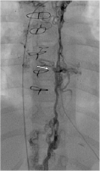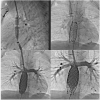Transcatheter interventions in patients with a Fontan circulation: Current practice and future developments
- PMID: 36110107
- PMCID: PMC9468446
- DOI: 10.3389/fped.2022.965989
Transcatheter interventions in patients with a Fontan circulation: Current practice and future developments
Abstract
The Fontan operation represents the last of multiple steps that are offered a wide range of congenital cardiac lesions with a single ventricle (SV) physiology. Nowadays this surgical program consists of a total cavopulmonary connection (TCPC), by anastomosing systemic veins to the pulmonary arteries (PAs), excluding the right-sided circulation from the heart. As a result of imaging, surgical, percutaneous, and critical care improvements, survival in this population has steadily increased. However, the Fontan physiology chronically increases systemic venous pressure causing systemic venous congestion and decreased cardiac output, exposing patients to the failure of the Fontan circulation (FC), which is associated with a wide variety of clinical complications such as liver disease, cyanosis, thromboembolism, protein-losing enteropathy (PLE), plastic bronchitis (PB), and renal dysfunction, ultimately resulting in an increased risk of exercise intolerance, arrhythmias, and premature death. The pathophysiology of the failing Fontan is complex and multifactorial; i.e., caused by the single ventricle dysfunction (diastolic/systolic failure, arrhythmias, AV valve regurgitation, etc.) or caused by the specific circulation (conduits, pulmonary vessels, etc.). The treatment is still challenging and may include multiple options and tools. Among the possible options, today, interventional catheterization is a reliable option, through which different procedures can target various failing elements of the FC. In this review, we aim to provide an overview of indications, techniques, and results of transcatheter options to treat cavopulmonary stenosis, collaterals, impaired lymphatic drainage, and the management of the fenestration, as well as to explore the recent advancements and clinical applications of transcatheter cavopulmonary connections, percutaneous valvular treatments, and to discuss the future perspectives of percutaneous therapies in the Fontan population.
Keywords: Fontan procedure; collaterals embolization; percutaneous interventions; percutaneous valve; stents.
Copyright © 2022 Jalal, Gewillig, Boudjemline, Guérin, Pilati, Butera, Malekzadeh-Milani, Avesani and Thambo.
Conflict of interest statement
The authors declare that the research was conducted in the absence of any commercial or financial relationships that could be construed as a potential conflict of interest.
Figures











References
-
- DeLeval MR, Kilner P, Gewillig M, Bull C. Total cavopulmonary connection: a logical alternative to atriopulmonary connection for complex Fontan operations. Experimental studies and early clinical experience. J Thorac Cardiovasc Surg. (1988) 96:682–95. - PubMed
Publication types
LinkOut - more resources
Full Text Sources
Research Materials

